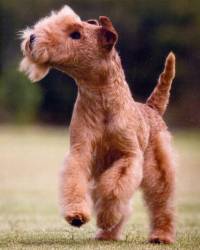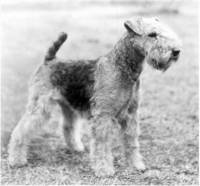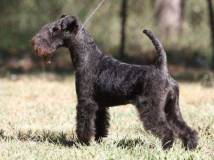Lakeland Terrier
 Lakeland Terrier (Wheaten)
Lakeland Terrier (Wheaten)
From the 1700s both the Lakeland and the Border Terrier shared the common purpose of fox hunting. A century later, their working heritage was reflected by the opening words written into their respective the Breed Standards. Today, the general appearance of the the Lakeland Terrier still contains the word 'workmanlike'.
History of the Lakeland Terrier
 Lakeland Terriers c 1930
Lakeland Terriers c 1930
The Lakeland Terrier was first developed to bolt the mountain fox indigenous to the Lakes District of England. Mountain foxes made their homes on the rocky ledges within caves.So, unlike the Border Terrier which worked in soft earth, the Lakeland had to bolt mountain foxes from their unforgiving rocky homes or dens. This required the Lakeland Terrier be sufficiently narrow in the chest to squeeze between the rocks and be able to retreat backwards without becoming jammed. They also had to have the length of leg to jump onto the ledges to bolt the mountain fox from its den[1].
The Lakeland Terrier becomes a Pure Breed
 Lakeland Terrier (Black and Tan)
Lakeland Terrier (Black and Tan)
The Lakeland Terrier was first recognized as a Pure Breed in 1928. But today there are still Terriers of the Border Region called Fell and Patterdale Terriers which work in the traditional manner in the Lakes District of England but are not yet recognized by the Kennel Club UK. So, whilst acknowledging these current working types of terriers, in-depth discussion here is confined to the recognized pure breed which is the Lakeland Terrier.
History of Lakeland Terriers in Australia
 Lakeland Terrier 1954
Lakeland Terrier 1954
In Australia, a couple of Lakeland Terrierss were imported into Victoria in the late 1940's. Then in 1954 Mr Fell and his daughter Sadie Moorby arrived here from England with the legendary dog 'Jims Swell' (pictured) plus a couple of well-bred bitches from the famous 'Blackwell' kennels in UK. These founded the Manesty Kennels which have had a great influence on the Lakeland Terrier here spanning 60 years.
The Lakeland Terrier Today
 Lakeland Terrier (Blue)
Lakeland Terrier (Blue)
At first glance, a Lakeland Terrier's outline looks like a Fox Terrier (Wire) or a Welsh Terrier (see table below) and built like the long legged terriers. But the Lakeland reflects the colours of other terriers of the Border Region that is blue and tan, red, wheaten, red grizzle, liver, blue and black and black and tan.
 Lakeland Terrier (Wheaten)
Lakeland Terrier (Wheaten)
The Breed Standard of the Lakeland Terrier is, in my opinion not sufficiently explicit to reflect these subtle differences. So, the Lakeland is presented here as a comparison with these other two outwardly similar breeds. Note the following features reflect the Lakeland's origin as a Terrier of the Border Region compared to the English origin of the Fox Terrier (Wire) and the Welsh:
- Despite the furnishings of the beard, the head should not have the elongated muzzle of the Welsh or the Fox Terrier (Wire)
- The ears are set lower on the skull than the Welsh or the Fox Terrier (Wire)
- The body is not as short as the Welsh or Fox Terrier (Wire)[3]
- The whole dog is smaller in both height and weight than either the Welsh or the Fox Terrier (Wire).
Comparison between Fox Terrier (Wire), Welsh and Lakeland Terriers
| Terrier | Fox Terrier (Wire) | Welsh Terrier | Lakeland Terrier |
|---|---|---|---|
|
|
|
|
|
| Height and Weight | Dogs not exceeding 39cm (15.5 in) at shoulder, bitches slightly less. Weight: ideally 8kg (18 lbs). | Not exceeding 39 cm (15.5 in) at shoulder. Weight: 9-9.5 kg (20 - 21 lbs). | Not exceeding 37 cm (14.5 in). Weight: Dogs 8 kg (17 lbs), bitches 7 kg (15 lbs). |
| Background | Old English White Terrier (rough coated) | Old English Black and Tan Terrier (rough coated) | Terrier of the Border Region |
| Head Proportions | Little difference in length between skull and foreface which is well filled up beneath the eyes. | Skull medium width. Medium length from stop to end of nose. Jaws rather deep. | Length of head from stop to tip of nose not exceeding that from occiput to stop |
| Ears | Top line of folded ears well above level of skull (Button Ears) | Set fairly high and carried forward close to cheek | Set neither too high or too low on head |
| Chest | Deep not broad | Good depth and moderate width | Chest reasonably narrow |
| Body Proportions | Back short | Back short | Back moderately short |
| Colour | White predominates with black, black and tan, or tan markings | Black and tan or black grizzle and tan | Black and tan, blue and tan, red, wheaten, red grizzle, liver, blue or black |
BREAKING NEWS.
We have now published a unique Terrier book 'Terriers Unveiled' Available at our sister site: https://rangeairevision.com/terriers-unveiled/
References and Further Reading
[1] Mr and Mrs Graham Spence, "Hutchinson's Dog Encyclopedia" Published by Hutchinson & Co. (Publishers) LTD., 34 - 36 Paternoster Row, London, E.C.4 1933 Pages 1121-1132
See also Jane Harvey DVD "Terriers Then & Now" Published Rangeaire Vision 2002-2004 ISBN 978-0-9804296-4-0


